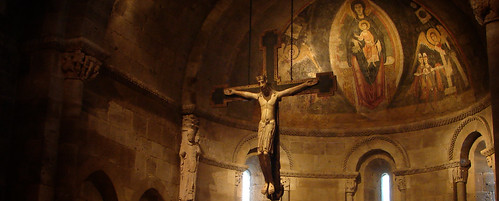The following is a reflection on John 3:14-21, the Gospel lesson for the Fourth Sunday in Lent, Year B, according to the Revised Common Lectionary.

The Romanesque crucifix hanging in the Fuentiduena Chapel in The Cloisters, NYC. Photo by Rick Morley.
The scene of the brazen serpent (in Numbers 21:4-9) immediately makes me recall the serpent in the Garden of Eden. That the Israelites were punished for their thanklessness with deadly biting serpents, and then forced to look upon the image of another serpent to find a cure, makes me think that God was trying to get the Israelites to remember what had transpired in Eden. However, scholarship and archaeology tells us that serpent images were used in ancient Israel, during the time of the unified monarchy, as a symbol of fertility, and that similar images were used in ancient Egypt as a talisman to repel living snakes. (See: Joines, Karen Randolph. “Bronze Serpent In The Israelite Cult.” Journal Of Biblical Literature 87.3 (1968): 245-256.)
That the Israelites had recently evacuated Egypt, what we may have here is a recollection of Egyptian practice. They were going to ward off the snakes in the same way as their captor Egyptians had done.
If one were going to preach on the brazen serpent, I think this would be a decent place to start—or at least have in the back of one’s mind.
However, when this scene is referenced in the third chapter of the Gospel of John, I don’t think this that this is what Jesus had in mind at all. It has nothing to do with fertility, Egyptian practice, or even the history of the Exodus. It seems that the brazen serpent is used here to speak about Jesus’ crucifixion in two ways:
- As a way to highlight the crucifixion as a “lifting up,”
- and as a way to say that the passion of Christ provides a remedy, and the promise of life.
Unlike the synoptic Gospels, John’s Gospel presents the crucifixion not as an event of horror and humiliation, but as exaltation. There are no great drops of sweat. No crying out, “My God, my God, why have you forsaken me?”
No, in John it’s an enthronement. It’s the moment of coronation where Jesus’ kingship is fulfilled and proclaimed.
And, in this moment, Jesus is lifted high for everyone to behold. In the words of Simeon in the Gospel of Luke: “My eyes have seen the savior whom you have prepared for all the world to see; a light to enlighten the nations, and the glory of your people, Israel.”
But, the event of the cross isn’t just an advertisement, or a show. It actually does something. The cross is effectual.
Just like when the Israelites looked at the brazen serpent they were able to be healed, the cross has the power to heal and give life too. But, according to John, gazing upon it isn’t enough.
You need to have faith. You need to be moved to believe. Which is, of course, what the entire third chapter of John is all about.
For God so loved the world that he gave his only Son, so that everyone who believes in him may not perish but may have eternal life.
This conversation that begins with Nicodemus coming to Jesus at night becomes a sermon on the reign of God which is made manifest on Calvary, and what the reign of God calls us to be in response: people of faith. Not like the Israelites in the wilderness, complaining that the manna was bland—but people feasting on the manna that God provides with thankfulness and faithful recognition of Our King.
1 Comment